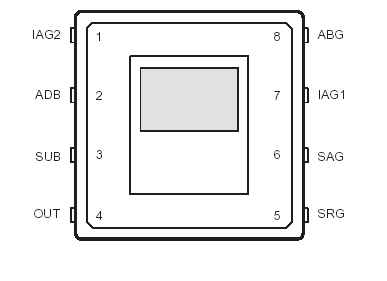Features: • Medium-Resolution, Solid-State Image Sensor for Low-Cost Color TV Applications
• 324(H) x 243(V) Active Elements in Image Sensing Area
• 10-mm Square Pixels
• Small Size
• Low Cost
• Fast Clear Capability
• Electronic Shutter Function From 1/601/50000 s
• Low Dark Current
• Electron-Hole Recombination Antiblooming
• Dynamic Range . . . 66 dB Typical
• High Sensitivity
• High Blue Response
• 8-Pin Dual-In-Line Plastic Package
• 4-mm Image-Area Diagonal
• Solid-State Reliability With No Image Burn-In, Residual Imaging, Image Distortion, Image Lag, or MicrophonicsPinout Specifications
SpecificationsSupply voltage range, VCC: ADB (see Note 1)........................... 0 V to 15 V
Input voltage range, VI: ABG, IAG1, IAG2, SAG, SRG ............15 V to 15 V
Operating free-air temperature range, TA ............................10 to 45
Storage temperature range, TSTG ........................................30 to 85
† Stresses beyond those listed under "absolute maximum ratings" may cause permanent damage to the device. These are stress ratings only, and functional operation of the device at these or any other conditions beyond those indicated under "recommended operating conditions" is not implied. Exposure to absolute-maximum-rated conditions for extended periods may affect device reliability.
NOTE 1: All voltages are with respect to the substrate terminal.
DescriptionThe TC254P is a frame-transfer charge-coupled device (CCD) designed for use in color NTSC TV and specialpurpose applications requiring low cost and small size.
The image-sensing area of the TC254P is configured in 243 lines with 336 elements in each line. Twelve elements are provided in each line for dark reference. The blooming-protection feature of the sensor is based on recombining excess charge with charge of opposite polarity in the substrate. This antiblooming is activated by supplying clocking pulses to the antiblooming gate, which is an integral part of each image-sensing element.
The sensor can be operated in a non-interlace mode as a 324(H) by 243(V) square color pixel mode by alternately averaging two red pixels for red pixels and two blue pixels for blue pixels. Because the human eye is most sensitive to the green light wavelength, the 324×243 resolution is preserved due to the orientation of the green pixels in the Bayer mosaic color filter pattern.
The device can also be operated in a 162(H) by 121(V) square color pixel mode by utilizing a separate red, two averaged greens, and a blue pixel for each color pixel. In this mode, true interlaced video is possible, effectively increasing the vertical resolution, by performing a one pixel shift during the off-chip video processing.
One important aspect of this image sensor is its high-speed image-transfer capability. This capability allows for an electronic shutter function comparable to interline-transfer and frame-interline-transfer sensors without the loss of sensitivity and resolution inherent in those technologies.

 TC254P Data Sheet
TC254P Data Sheet







